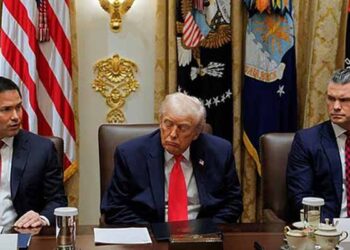Select Language:
Israeli forces and Hamas have reached an agreement on the initial phase of U.S. President Donald Trump’s plan for Gaza—a ceasefire and hostage exchange that could serve as a first step toward ending a conflict that has lasted for more than two years and destabilized the Middle East.
Details are still emerging, but here’s what’s known so far:
20-Point Framework
This initial agreement stems from indirect negotiations in Egypt, coming just a day after the second anniversary of Hamas’ October 7 attack on Israel. Trump announced that both parties have approved the first phase of the plan, which includes the imminent release of all hostages, both living and deceased, and the withdrawal of Israeli troops to what has been called the yellow line in Gaza. A senior Israeli security official states this marks a boundary for an initial Israeli troop pullback under Trump’s plan. Hamas also confirmed reaching a deal to end the war, including Israeli withdrawal and a prisoner exchange, but emphasized the need for Trump and guarantor nations to ensure Israel fully implements the ceasefire.
Unresolved Questions
Many crucial details remain uncertain, such as the timing of further steps, the future administration governing Gaza, and the future role of Hamas. There’s no clarity on who will lead Gaza after the conflict ends. Israel, the U.S., Western, and Arab nations have all ruled out Hamas participating in governance, which Hamas has controlled since 2007. Trump’s original plan envisions a role for the Palestinian Authority, conditional on its reform.
Next Steps
Israeli Prime Minister Benjamin Netanyahu has said he will hold a cabinet meeting to approve the agreement. Hamas reports that the first batch of released hostages will likely happen within 72 hours of Israeli approval. Israel expects the hostages’ release will start Saturday, with about 20 of the 48 hostages believed to still be alive. A White House official notes that once Israel gives the go-ahead, they will withdraw within 24 hours, after which a 72-hour countdown for hostage release begins—expected to start Monday.
Hamas claims it has provided lists of hostages and Palestinian prisoners it seeks to swap. U.S. President Trump is considering regional visits soon and has invited to address Israel’s parliament, which he has indicated he’s willing to do. The next phase involves an international “Board of Peace,” led by Trump and including former UK Prime Minister Tony Blair, overseeing Gaza’s post-war administration.
Potential Risks
Success in this deal would be a major foreign policy win for Trump, who has long promised to bring quick resolution to conflicts in Gaza and Ukraine—a promise that has proven more challenging than anticipated. Hamas has yet to agree to Israeli demands to disarm, citing ongoing Israeli occupation of Palestinian lands as a barrier. Disagreements also persist on the timeline for Israeli troop withdrawal and guarantees attached to the ceasefire.
While Israel has scaled back military operations in Gaza based on Trump’s encouragement, strikes have not stopped entirely. Arab nations backing the plan emphasize the goal of eventually establishing an independent Palestinian state, a prospect Israel’s Netanyahu firmly rejects. Hamas has indicated it would only cede Gaza governance to a Palestinian technocratic government overseen by the Palestinian Authority and supported by Arab and Muslim countries, rejecting any external or foreign control like that proposed by Blair.
The list of prisoners Hamas aims to free includes some of the most prominent figures ever held by Israel, such as Fatah leader Marwan al-Barghouti and Ahmed Saadat of the Popular Front for the Liberation of Palestine—both serving multiple life sentences. The peace process remains delicate, with many hurdles still to overcome before a stable resolution can be achieved.







